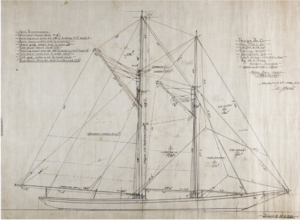I am preparing to build a model of the 1921 Canadian Schooner from scratch and looking for a set of plans faithful to the original. But during my research I have found some irreconcilable discrepancies. I am looking for some help resolving them.
I am using the measured drawings by L. B. Jenson from his wonderful “Bluenose II – The saga of the Great Fishing Schooners” as my gold standard. This appears to be the most reliable source as the drawings were taken from the original carved wooden half-hull model and actual measurements of the Bluenose II. The Bluenose II is claimed to be “an exact and faithful reproduction of the original“.
The following are quotes from L. B. Jenson’s “Bluenose II – The Saga”: “The only departures from the first Bluenose are in the accommodations & stowage and in the addition of modern navigation devices now required for sea-going certification.” and, “Mr. Fred Rhuland, one of the original builders of Bluenose II, very kindly made the original half-hull model of Bluenose available to me to copy. This of course forms the basis of the hull drawings and, insofar as possible for me to determine, checks out precisely with the actual hull of Bluenose II”.
Lathan B. Jenson’s “Bluenose II – The saga of the Great Fishing Schooners” was first published in 1994, but is an adaptation and expansion of his portfolio “Bluenose II, The Last of the Tall Schooners”.
In addition to the L. B. Jenson measured drawings I have been looking at three other model ship plan sets. The first was drafted by H. W. Porter in 1940. The second was drafted by Phillip I. Eisnor in 1988, and lastly plans offered by Model Expo, Bluenose MS2130. The Model Expo plans are the ones in the Model Shipways 1:64 scale kit. I do not know the providence of the Model Shipways plans, but am interested to learn.
Now before I launch into my findings, I want to apologize in advance of any perceived slights that readers may infer from my word choice or method of presentation. Whenever two opposing views are presented, there is a possibility of offense taken on one side or the other. I do not mean any disrespect and the opinions and interpretations here are wholly my own. Secondly, I will be presenting pictures and statements that I have found in the public domain and will attempt to give credit wherever possible. If someone has an issue with my findings, or feels I am violating some copyright law, please let me know and I will remove the offending artifact. Also, I will be presenting pictures of plans, but will be using blurred versions that are already viewable elsewhere for advertising purposes. None of my posting of plans could be used by anyone to build a model.
When looking at all of the collected research materials, I am most concerned with the discrepancies related to the shape of the ship’s hull. Particularly differences in the aft end, the shape of the transom, the curve of the bow and the shape of the rudder. L. B Jenson’s drawing show a Bluenose with a very sleek, streamline aft, ending in a small roundish transom. Whereas, the other three sets of plans show a standard Gloucester Schooner aft end, not so tapered, squarer when viewed from above with a wider oval transom. Also, the rudder shapes are quite different. L. B. Jenson’s drawing shows the rudder with its center of area higher than shown in any of the plan sets. The bow of the Bluenose, according to L. B. Jenson, corroborated with pictures and videos of the original Bluenose, has a profile with a smooth curve with a constant decreasing rate of curvature fore to aft. Whereas a couple of the other plans show an abrupt change in the rate of curve at the bow commonly seen in other schooners.
Let us start at the aft. Compare the top views of the aft end of the Bluenose focusing on the narrowing of the shear and the shape of the transom:
The original Bluenose from L. B. Jenson’s drawings:
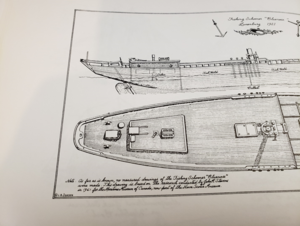
From H. W. Porter’s 1940 plans, the rear is squarer and wider:
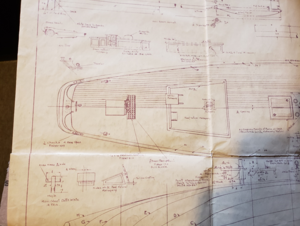
Phillip Eisnor’s plans similarly has a square aft:
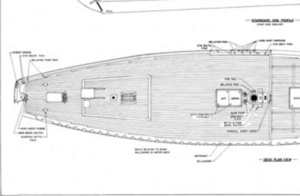
Found here: http://www.modelshipbuilder.com/page.php?26
And the Model Expo plans aft end:
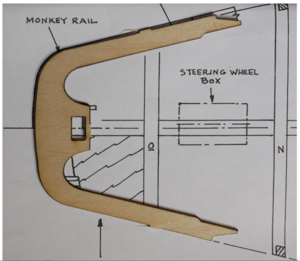
The squarer aft in the Model Shipways kit:
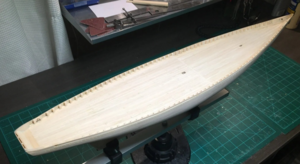
The last two pictures are from:

Comparing the transoms:
from L. B. Jenson’s drawings, the transom is almost heart shaped when viewed from the rear:
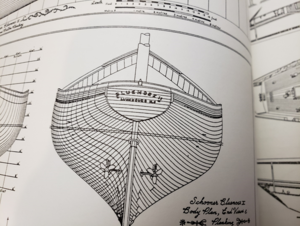
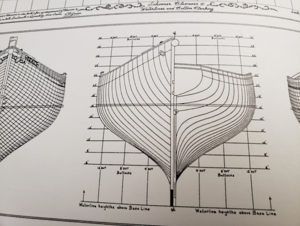
Whereas the transom from Phillip Eisnor’s plans is wider and more oval:
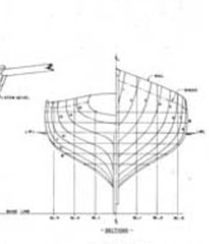
Now, the rudder:
L. B. Jenson’s drawing of the rudder:
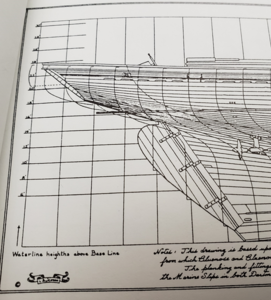
From H. W. Porter’s 1940 plans:
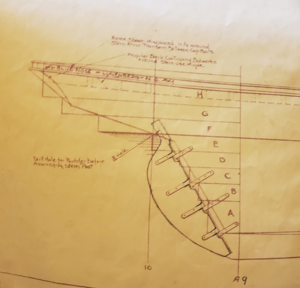
Phillip Esinor’s rudder:
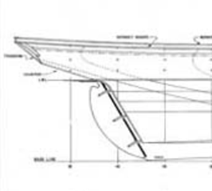
Model Shipways rudder:
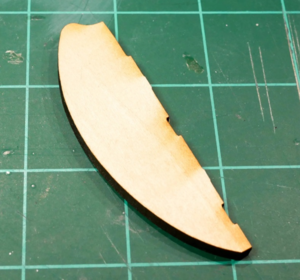
The above is again from Suburbanshipbuilder.
I am not so concerned with the different shaped rudders. They are just indicative of all of the plan’s deviations from the original, that is, if you accept L. B. Jenson as the gold standard.
Now let us turn our attention to the bow.
In Phillip Eisnor’s plans and Model Shipways plans there is what I call a “knee” in the curvature of the bow. This is a section where the rate of curve moving from the bowsprit down the keel, abruptly increases, then decreases.
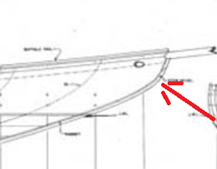
Below is another example of a schooner, the “Henery W. Adams” that has the “Knee” in the curve of the bow. It is like there is an almost vertical cutwater that then curves into the keel at the “Knee”.
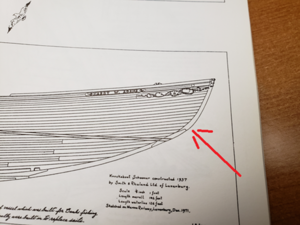
Below is the model shipways kit, also with this “Knee”:
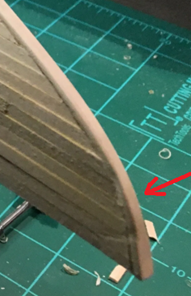
Interestingly, the plan set that comes the closest to L. B. Jenson’s drawings is the one from H. W. Porter. There is no “knee”, but the bow looks more swept back than the original Bluenose:
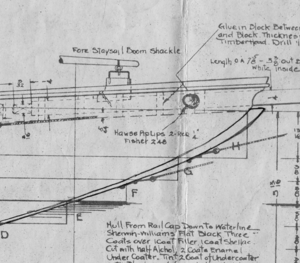
Below is the drawing from L. B. Jenson of the Bluenose bow. The curve starts at the bowsprit and as it moves down the keel the rate of curve decrease, that is it flattens out, without the abrupt change in direction of the rate of curvature. There is no “Knee”.
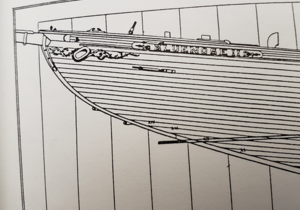
I have found photos and the video below that corroborate the smooth continuous curvature of the Bluenose bow.
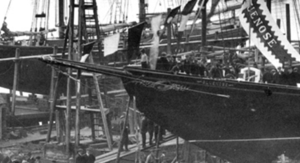
And:
So, there you have it. Please share your views on the evidence I have presented. I may end up purchasing a set of plans and then modify them to more closely resemble J. B. Jenson’s drawings. Given the money and time invested in building a model ship, one wants it to represent the actual ship as closely as possible.
I do not know anything about sailing ship design, but I wonder if any of these differences between the Bluenose hull shape and other typical schooner hull shapes, resulted in her superior speed and, some say, undefeated racing record.
I am using the measured drawings by L. B. Jenson from his wonderful “Bluenose II – The saga of the Great Fishing Schooners” as my gold standard. This appears to be the most reliable source as the drawings were taken from the original carved wooden half-hull model and actual measurements of the Bluenose II. The Bluenose II is claimed to be “an exact and faithful reproduction of the original“.
The following are quotes from L. B. Jenson’s “Bluenose II – The Saga”: “The only departures from the first Bluenose are in the accommodations & stowage and in the addition of modern navigation devices now required for sea-going certification.” and, “Mr. Fred Rhuland, one of the original builders of Bluenose II, very kindly made the original half-hull model of Bluenose available to me to copy. This of course forms the basis of the hull drawings and, insofar as possible for me to determine, checks out precisely with the actual hull of Bluenose II”.
Lathan B. Jenson’s “Bluenose II – The saga of the Great Fishing Schooners” was first published in 1994, but is an adaptation and expansion of his portfolio “Bluenose II, The Last of the Tall Schooners”.
In addition to the L. B. Jenson measured drawings I have been looking at three other model ship plan sets. The first was drafted by H. W. Porter in 1940. The second was drafted by Phillip I. Eisnor in 1988, and lastly plans offered by Model Expo, Bluenose MS2130. The Model Expo plans are the ones in the Model Shipways 1:64 scale kit. I do not know the providence of the Model Shipways plans, but am interested to learn.
Now before I launch into my findings, I want to apologize in advance of any perceived slights that readers may infer from my word choice or method of presentation. Whenever two opposing views are presented, there is a possibility of offense taken on one side or the other. I do not mean any disrespect and the opinions and interpretations here are wholly my own. Secondly, I will be presenting pictures and statements that I have found in the public domain and will attempt to give credit wherever possible. If someone has an issue with my findings, or feels I am violating some copyright law, please let me know and I will remove the offending artifact. Also, I will be presenting pictures of plans, but will be using blurred versions that are already viewable elsewhere for advertising purposes. None of my posting of plans could be used by anyone to build a model.
When looking at all of the collected research materials, I am most concerned with the discrepancies related to the shape of the ship’s hull. Particularly differences in the aft end, the shape of the transom, the curve of the bow and the shape of the rudder. L. B Jenson’s drawing show a Bluenose with a very sleek, streamline aft, ending in a small roundish transom. Whereas, the other three sets of plans show a standard Gloucester Schooner aft end, not so tapered, squarer when viewed from above with a wider oval transom. Also, the rudder shapes are quite different. L. B. Jenson’s drawing shows the rudder with its center of area higher than shown in any of the plan sets. The bow of the Bluenose, according to L. B. Jenson, corroborated with pictures and videos of the original Bluenose, has a profile with a smooth curve with a constant decreasing rate of curvature fore to aft. Whereas a couple of the other plans show an abrupt change in the rate of curve at the bow commonly seen in other schooners.
Let us start at the aft. Compare the top views of the aft end of the Bluenose focusing on the narrowing of the shear and the shape of the transom:
The original Bluenose from L. B. Jenson’s drawings:

From H. W. Porter’s 1940 plans, the rear is squarer and wider:

Phillip Eisnor’s plans similarly has a square aft:

Found here: http://www.modelshipbuilder.com/page.php?26
And the Model Expo plans aft end:

The squarer aft in the Model Shipways kit:

The last two pictures are from:

Comparing the transoms:
from L. B. Jenson’s drawings, the transom is almost heart shaped when viewed from the rear:


Whereas the transom from Phillip Eisnor’s plans is wider and more oval:

Now, the rudder:
L. B. Jenson’s drawing of the rudder:

From H. W. Porter’s 1940 plans:

Phillip Esinor’s rudder:

Model Shipways rudder:

The above is again from Suburbanshipbuilder.
I am not so concerned with the different shaped rudders. They are just indicative of all of the plan’s deviations from the original, that is, if you accept L. B. Jenson as the gold standard.
Now let us turn our attention to the bow.
In Phillip Eisnor’s plans and Model Shipways plans there is what I call a “knee” in the curvature of the bow. This is a section where the rate of curve moving from the bowsprit down the keel, abruptly increases, then decreases.

Below is another example of a schooner, the “Henery W. Adams” that has the “Knee” in the curve of the bow. It is like there is an almost vertical cutwater that then curves into the keel at the “Knee”.

Below is the model shipways kit, also with this “Knee”:

Interestingly, the plan set that comes the closest to L. B. Jenson’s drawings is the one from H. W. Porter. There is no “knee”, but the bow looks more swept back than the original Bluenose:

Below is the drawing from L. B. Jenson of the Bluenose bow. The curve starts at the bowsprit and as it moves down the keel the rate of curve decrease, that is it flattens out, without the abrupt change in direction of the rate of curvature. There is no “Knee”.

I have found photos and the video below that corroborate the smooth continuous curvature of the Bluenose bow.

And:
So, there you have it. Please share your views on the evidence I have presented. I may end up purchasing a set of plans and then modify them to more closely resemble J. B. Jenson’s drawings. Given the money and time invested in building a model ship, one wants it to represent the actual ship as closely as possible.
I do not know anything about sailing ship design, but I wonder if any of these differences between the Bluenose hull shape and other typical schooner hull shapes, resulted in her superior speed and, some say, undefeated racing record.






